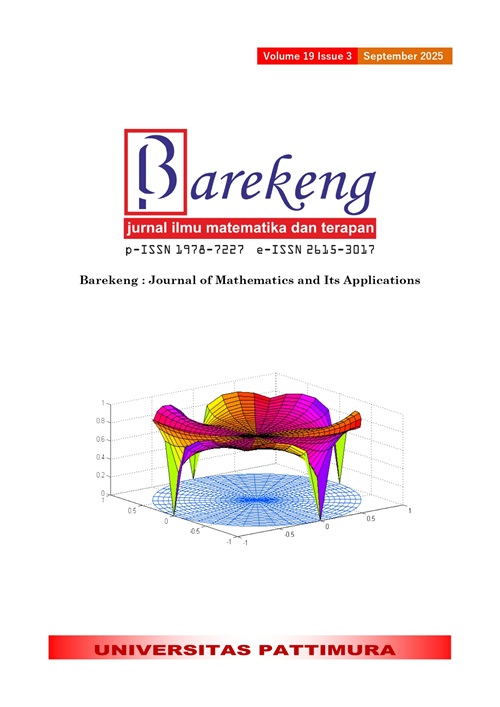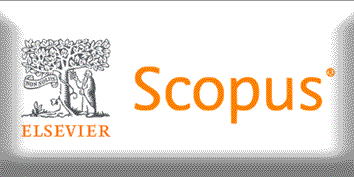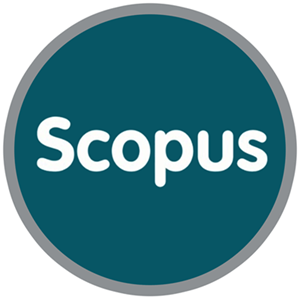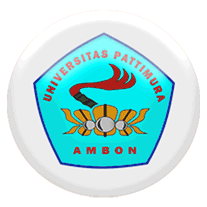COMPARISON BETWEEN BAYESIAN QUANTILE REGRESSION AND BAYESIAN LASSO QUANTILE REGRESSION FOR MODELING POVERTY LINE WITH PRESENCE OF HETEROSCEDASTICITY IN WEST SUMATRA
Abstract
The poverty line is the threshold income level below which a person or household is considered to be living in poverty. The poverty line is a representation of the minimum rupiah amount needed to meet the minimum basic food needs equivalent to 2100 kilocalories per capita per day and basic non-food needs. According to data from the Central Bureau of Statistics (BPS), although the poverty rate in West Sumatra has decreased in recent years, the issue of poverty is still very relevant to be discussed and addressed. The issue of the poverty line is important to discuss because it is directly related to the welfare of people and the development of a country. For modeling the poverty line and its influencing factors, appropriate statistical methods are needed. This research is about the comparison of two methods, namely the Bayesian quantile regression method and Bayesian LASSO quantile regression. The two methods are compared with the aim of seeing which method produces the smallest error. Bayesian quantile regression is one method that can model data assuming heteroscedasticity violations. This study compares the ordinary Bayesian quantile regression method with penalized LASSO. These two methods are applied in modeling the poverty line in West Sumatra. The purpose of this study is to see the best method for modeling data. The data used amounted to 133 data points from BPS in the years 2017 and 2023. Model parameters were estimated using MCMC with a Gibbs sampling approach. The results show that the Bayesian LASSO method is superior to the method without LASSO. This is evidenced that the superior method produces the smallest MSE value, 0.208, at quantile 0.5. Model poverty line in West Sumatra is significantly influenced by per capita spending ), Gross Regional Domestic Product ), Human Development Index ), Open Unemployment Rate , and minimum wages .
Downloads
References
I. Maipita, MENGUKUR KEMISKINAN & DISTRIBUSI PENDAPATAN. Upp Stim Ykpn, 2014.
L. H. Hasibuan and S. Musthofa, “PENERAPAN METODE REGRESI LINEAR SEDERHANA UNTUK PREDIKSI HARGA BERAS DI KOTA PADANG,” JOSTECH J. Sci. Technol., vol. 2, no. 1, pp. 85–95, 2022.
F. Yanuar, A. S. Deva, M. Maiyastri, H. Yozza, and A. Zetra, “MODELING LENGTH OF HOSPITAL STAY FOR PATIENTS WITH COVID-19 IN WEST SUMATRA USING QUANTILE REGRESSION APPROACH,” CAUCHY J. Mat. Murni dan Apl., vol. 7, no. 1, pp. 118–128, 2021.
R. Alhamzawi, “MODEL SELECTION IN QUANTILE REGRESSION MODELS,” J. Appl. Stat., vol. 42, no. 2, pp. 445–458, 2015.
R. Tibshirani, “REGRESSION SHRINKAGE AND SELECTION VIA THE LASSO,” J. R. Stat. Soc. Ser. B Stat. Methodol., vol. 58, no. 1, pp. 267–288, 1996.
A. S. Sholih, L. H. Hasibuan, and I. D. Rianjaya, “ANALISIS REGRESI LOGISTIK ORDINAL TERHADAP FAKTOR-FAKTOR YANG MEMPENGARUHI PREDIKAT KELULUSAN MAHASISWA SARJANA UIN IMAM BONJOL PADANG,” MAp (Mathematics Appl. J., vol. 6, no. 2, pp. 99–110, 2024.
L. H. Hasibuan, D. M. Putri, and M. Jannah, “PENERAPAN METODE LEAST SQUARE UNTUK MEMPREDIKSI JUMLAH PENERIMAAN MAHASISWA BARU,” MAp (Mathematics Appl. J., vol. 4, no. 1, pp. 33–39, 2022.
L. H. Hasibuan, D. M. Putri, and M. Jannah, “SIMPLE LINEAR REGRESSION METHOD TO PREDICT COOKING OIL PRICES IN THE TIME OF COVID-19,” Logaritma J. Ilmu-ilmu Pendidik. dan Sains, vol. 10, no. 01, pp. 81–94, 2022.
L. H. Hasibuan, F. Yanuar, D. Devianto, and M. Maiyastri, “QUANTILE REGRESSION ANALYSIS; SIMULATION STUDY WITH VIOLATION OF NORMALITY ASSUMPTION,” JOSTECH J. Sci. Technol., vol. 4, no. 2, pp. 133–142, 2024.
Y. Yacoub, “PENGARUH TINGKAT PENGANGGURAN TERHADAP TINGKAT KEMISKINAN KABUPATEN/KOTA DI PROVINSI KALIMANTAN BARAT,” 2013.
R. Koenker, “QUANTILE REGRESSION FOR LONGITUDINAL DATA,” J. Multivar. Anal., vol. 91, no. 1, pp. 74–89, 2004.
K. Yu, Z. Lu, and J. Stander, “QUANTILE REGRESSION: APPLICATIONS AND CURRENT RESEARCH AREAS,” J. R. Stat. Soc. Ser. D Stat., vol. 52, no. 3, pp. 331–350, 2003.
F. Yanuar, “THE SIMULATION STUDY TO TEST THE PERFORMANCE OF QUANTILE REGRESSION METHOD WITH HETEROSCEDASTIC ERROR VARIANCE,” Cauchy J. Mat. Murni dan Apl., vol. 5, no. 1, pp. 36–41, 2017.
F. Yanuar, M. Q. Shobri, R. F. Mabrur, I. H. Putri, and A. Zetra, “CLASSIFICATION OF DEATH RISK FOR COVID-19 PATIENTS USING BAYESIAN LOGISTIC REGRESSION AND NAIVE BAYES CLASSIFIER,” IAENG Int. J. Comput. Sci., vol. 50, no. 3, pp. 915–920, 2023.
M. C. Korkmaz, E. Altun, C. Chesneau, and H. M. Yousof, “ON THE UNIT-CHEN DISTRIBUTION WITH ASSOCIATED QUANTILE REGRESSION AND APPLICATIONS,” Math. Slovaca, vol. 72, no. 3, pp. 765–786, 2022.
F. Yanuar, H. Yozza, and I. Rahmi, “PENERAPAN METODE REGRESI KUANTIL PADA KASUS PELANGGARAN ASUMSI KENORMALAN SISAAN,” Eksakta, vol. 1, pp. 33–37, 2016.
K. Yu and R. A. Moyeed, “BAYESIAN QUANTILE REGRESSION,” Stat. Probab. Lett., vol. 54, no. 4, pp. 437–447, 2001.
R. Alhamzawi and H. T. M. Ali, “BRQ: AN R PACKAGE FOR BAYESIAN QUANTILE REGRESSION,” Metron, vol. 78, no. 3, pp. 313–328, 2020.
F. Yanuar, A. S. Deva, and A. Zetra, “LENGTH OF HOSPITAL STAY MODEL OF COVID-19 PATIENTS WITH QUANTILE BAYESIAN WITH PENALTY LASSO,” Commun. Math. Biol. Neurosci., vol. 2023, p. Article-ID, 2023.
F. Yanuar, A. Zetra, A. R. Putri, and Y. Asdi, “BAYESIAN LASSO QUANTILE REGRESSION: AN APPLICATION TO THE MODELING OF LOW BIRTH WEIGHT,” 2020.
E. N. A. Ningtias and A. F. Anwar, “MENGUKUR DAMPAK PENGANGGURAN, TINGKAT PENDIDIKAN, UPAH MINIMUM, DAN PENGELUARAN PER KAPITA TERHADAP KEMISKINAN DI KOTA MAKASSAR,” Bull. Econ. Stud., vol. 1, no. 1, 2021.
L. Leonita and R. K. Sari, “PENGARUH PDRB, PENGANGGURAN DAN PEMBANGUNAN MANUSIA TERHADAP KEMISKINAN DI INDONESIA,” ISOQUANT J. Ekon. Manaj. dan Akunt., vol. 3, no. 2, pp. 1–8, 2019.
Y. C. Pratama, “ANALISIS FAKTOR-FAKTOR YANG MEMPENGARUHI KEMISKINAN DI INDONESIA,” 2014.
Y. Andriyana, J. Suprijadi, Y. Suparman, S. Winarni, and I. Jaya, “MODELLING THE PERCENTAGE OF POVERTY BASED ON AN OPEN UNEMPLOYMENT RATE USING SOME NONPARAMETRIC REGRESSION TECHNIQUES,” in Journal of Physics: Conference Series, 2019, vol. 1265, no. 1, p. 12023.
B. P. S. S. Barat, “BADAN PUSAT STATISTIK,” BPS Sumatera Barat, 2023. https://sumbar.bps.go.id/.
R. Koenker, V. Chernozhukov, X. He, and L. Peng, “HANDBOOK OF QUANTILE REGRESSION,” 2017.
D. C. Montgomery, E. A. Peck, and G. G. Vining, INTRODUCTION TO LINEAR REGRESSION ANALYSIS. John Wiley & Sons, 2021.
R. Koenker and K. F. Hallock, “QUANTILE REGRESSION,” J. Econ. Perspect., vol. 15, no. 4, pp. 143–156, 2001.
C. Davino, M. Furno, and D. Vistocco, QUANTILE REGRESSION: THEORY AND APPLICATIONS, vol. 988. John Wiley & Sons, 2013.
R. J. T. Al-Hamzawi, “Prior Elicitation And Variable Selection For Bayesian Quantile Regression.” Brunel University, School of Information Systems, Computing and Mathematics, 2013.
L. J. Bain and M. Engelhardt, INTRODUCTION TO PROBABILITY AND MATHEMATICAL STATISTICS., vol. 49, no. 2. 1993.
Copyright (c) 2025 Lilis Harianti Hasibuan, Ferra Yanuar, Dodi Devianto, Maiyastri Maiyastri, Rudiyanto Rudiyanto

This work is licensed under a Creative Commons Attribution-ShareAlike 4.0 International License.
Authors who publish with this Journal agree to the following terms:
- Author retain copyright and grant the journal right of first publication with the work simultaneously licensed under a creative commons attribution license that allow others to share the work within an acknowledgement of the work’s authorship and initial publication of this journal.
- Authors are able to enter into separate, additional contractual arrangement for the non-exclusive distribution of the journal’s published version of the work (e.g. acknowledgement of its initial publication in this journal).
- Authors are permitted and encouraged to post their work online (e.g. in institutional repositories or on their websites) prior to and during the submission process, as it can lead to productive exchanges, as well as earlier and greater citation of published works.






1.gif)



